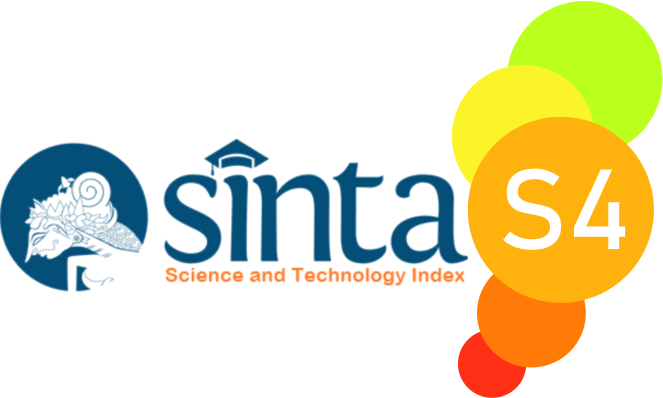Approaches and Methods to Teaching Grammar in Textbooks Used in First Semester of English Department Students at ABA Balikpapan
Abstract
This study aims to describe, compare, and contrast approaches and methods to teaching grammar in textbooks used in First Semester of English Department Students at ABA Balikpapan. It chooses, as samples for analysis, textbooks of one particular class to focus on the approaches to teaching grammar in these textbooks. These textbooks are taught for first intermediate class and belong to two different series titled First Semester of English Department Students at ABA Balikpapan opportunities and English for First Semester of English Department Students at ABA Balikpapan. Each of these textbooks follows essentially different approaches to teaching grammar. This study aims to highlight the similarities and differences between the books and reveals the weaknesses and strengths of the approaches in these books. The purpose of the study is changing these textbooks and to reveal the similarities and differences between the old and new textbooks. The data collection method of this research is the collation texts for analysis. The information is breaking down subjectively and quantitatively. The study considerably contributes to the field of language teaching in First Semester of English Department Students at ABA Balikpapan especially grammar teaching through drawing attention of language lecturers, textbook writers, as well as learners to a certain degree, to the weaknesses and strengths of the PPP method (Presentation Practice Production) in the First Semester of English Department Students at ABA Balikpapan opportunities textbook and task-based approach in the English for First Semester of English Department Students at ABA Balikpapan textbook.
References
Ellis, R. (1994). The study of second language acquisition. Oxford: Oxford University Press.
Ellis, R. (1997). SLA Research and language teaching. Oxford: Oxford University Press.
Ellis, R. (2001). Task-based language teaching and learning. Oxford: Oxford University Press.
Ellis, R. (2003). Task-based language learning and teaching. Oxford: Oxford University Press.
Fotos, S. (1993). Consciousness-raising and noticing through focus on form- grammar-task-performance versus formal instruction. Applied Linguistics, 14, 385-407.
Fotos, S. (1994). Integrating grammar instruction and communicative language use through grammar consciousness-raising tasks. TESOL Quarterly, 28, 323- 51.
Juita, E. (2021). Speaking Assessment for Students of Medical Laboratory Technology. Journey (Journal of English Language and Pedagogy), 4(1), 1-10. https://doi.org/10.33503/journey.v4i1.1227
Long, M., and Crookes, G. (1992). Three approaches to task-based syllabus design. TESOL Quarterly, 26, 27-56.
Mendelay, Zotero, etc E. (2021). Speaking Assessment for Students of Medical
Laboratory Taechnology. Vol 4 No 1 (2021): Journey: Journal of English Language and Pedagogy.
Nassaji, H. (1999). Towards integrating form-focused instruction and communicative interaction in the second language classroom: Some pedagogical possibilities. Canadian Modern Language Review, 55, 385-402.
Nassaji, H. (2009). Effects of recasts and elicitations in dyadic interaction and the role of feedback explicitness. Language Learning, 59, 411-52.
Nassaji, H., and Fotos, S. (2004). Current development in research on the teaching of grammar. Annual Review of Applied Linguistics, 24, 126-45.
Nassaji, H., and Fotos, S. (2011). Teaching grammar in second language classrooms: Integrating form-focused instruction in communicative context. New York: Routledge.
Nunan, D. (2004). Task-based language teaching: A comprehensively revised edition of designing tasks for the communicative classroom. Oxford: Oxford University Press.
Pienemann, M. (1998). Language processing and second language development: Processability theory. Amsterdam: John Benjamins.
Richards. J. C. and Rodgers. T. (2001). Approaches and methods in language teaching: A description and analysis. Cambridge: Cambridge University Press.
Samuda, V. And Bygate, M. (2008). Tasks in second language learning. New York: Palgrave-Macmillan.
Setiyowati, Ninik, M. (2018) An Analysis of English Grammar Teaching in the English Textbook “When English Rings as Bell” used in SMPN Sawit Boyolali. As cited in http://eprints.ums.ac.id/69284/13/PUBLICATION%20ARTICLE.pdf
Skehan, P. (1996). Second language acquisition research and task-based instruction. In: Willis, J. and Willis, D. (eds.) Challenge and change in language teaching. Oxford: Heinemann. pp. 17-30.
VanPatten, B. (1996). Input processing and grammar instruction in second language acquisition. Norwood, NJ: Ablex.
Wong, W. (2005). Input enhancement: From theory and research to the classroom. New York: McGraw-Hill.
Copyright (c) 2023 Muhammad Rochman

This work is licensed under a Creative Commons Attribution-ShareAlike 4.0 International License.

Journey: Journal of English Language and Pedagogy by http://ejurnal.budiutomomalang.ac.id/index.php/journey/index is licensed under a Creative Commons Attribution-ShareAlike 4.0 International License.






